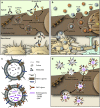Emerging Technologies for Delivery of Biotherapeutics and Gene Therapy Across the Blood-Brain Barrier
- PMID: 30306341
- PMCID: PMC6290705
- DOI: 10.1007/s40259-018-0309-y
Emerging Technologies for Delivery of Biotherapeutics and Gene Therapy Across the Blood-Brain Barrier
Abstract
Antibody, immuno- and gene therapies developed for neurological indications face a delivery challenge posed by various anatomical and physiological barriers within the central nervous system (CNS); most notably, the blood-brain barrier (BBB). Emerging delivery technologies for biotherapeutics have focused on trans-cellular pathways across the BBB utilizing receptor-mediated transcytosis (RMT). 'Traditionally' targeted RMT receptors, transferrin receptor (TfR) and insulin receptor (IR), are ubiquitously expressed and pose numerous translational challenges during development, including species differences and safety risks. Recent advances in antibody engineering technologies and discoveries of RMT targets and BBB-crossing antibodies that are more BBB-selective have combined to create a new preclinical pipeline of BBB-crossing biotherapeutics with improved efficacy and safety. Novel BBB-selective RMT targets and carrier antibodies have exposed additional opportunities for re-targeting gene delivery vectors or nanocarriers for more efficient brain delivery. Emergence and refinement of core technologies of genetic engineering and editing as well as biomanufacturing of viral vectors and cell-derived products have de-risked the path to the development of systemic gene therapy approaches for the CNS. In particular, brain-tropic viral vectors and extracellular vesicles have recently expanded the repertoire of brain delivery strategies for biotherapeutics. Whereas protein biotherapeutics and bispecific antibodies enabled for BBB transcytosis are rapidly heading towards clinical trials, systemic gene therapy approaches for CNS will likely remain in research phase for the foreseeable future. The promise and limitations of these emerging cross-BBB delivery technologies are further discussed in this article.
Conflict of interest statement
All authors are employees of the Government of Canada. None have any existing conflict of interest with regard to this manuscript.
Figures

Similar articles
-
Strategies to identify, engineer, and validate antibodies targeting blood-brain barrier receptor-mediated transcytosis systems for CNS drug delivery.Expert Opin Drug Deliv. 2023 Jul-Dec;20(12):1789-1800. doi: 10.1080/17425247.2023.2286371. Epub 2023 Dec 29. Expert Opin Drug Deliv. 2023. PMID: 38007619 Free PMC article. Review.
-
Crossing the blood-brain-barrier with viral vectors.Curr Opin Virol. 2016 Dec;21:87-92. doi: 10.1016/j.coviro.2016.08.006. Epub 2016 Sep 1. Curr Opin Virol. 2016. PMID: 27591676 Review.
-
Differential expression of receptors mediating receptor-mediated transcytosis (RMT) in brain microvessels, brain parenchyma and peripheral tissues of the mouse and the human.Fluids Barriers CNS. 2020 Jul 22;17(1):47. doi: 10.1186/s12987-020-00209-0. Fluids Barriers CNS. 2020. PMID: 32698806 Free PMC article.
-
Engineering and pharmacology of blood-brain barrier-permeable bispecific antibodies.Adv Pharmacol. 2014;71:301-35. doi: 10.1016/bs.apha.2014.06.005. Epub 2014 Aug 23. Adv Pharmacol. 2014. PMID: 25307221 Review.
-
Smart Strategies for Therapeutic Agent Delivery into Brain across the Blood-Brain Barrier Using Receptor-Mediated Transcytosis.Chem Pharm Bull (Tokyo). 2020;68(4):316-325. doi: 10.1248/cpb.c19-00854. Chem Pharm Bull (Tokyo). 2020. PMID: 32238649 Review.
Cited by
-
An innovative strategy to identify new targets for delivering antibodies to the brain has led to the exploration of the integrin family.PLoS One. 2022 Sep 15;17(9):e0274667. doi: 10.1371/journal.pone.0274667. eCollection 2022. PLoS One. 2022. PMID: 36108060 Free PMC article.
-
Molecular architecture determines brain delivery of a transferrin receptor-targeted lysosomal enzyme.J Exp Med. 2022 Mar 7;219(3):e20211057. doi: 10.1084/jem.20211057. Epub 2022 Feb 28. J Exp Med. 2022. PMID: 35226042 Free PMC article.
-
Non-Invasive Delivery of Therapeutics into the Brain: The Potential of Aptamers for Targeted Delivery.Biomedicines. 2020 May 14;8(5):120. doi: 10.3390/biomedicines8050120. Biomedicines. 2020. PMID: 32422973 Free PMC article. Review.
-
The effects of dose, valency, and affinity on TfR-mediated brain delivery in vivo.Fluids Barriers CNS. 2025 Apr 8;22(1):36. doi: 10.1186/s12987-025-00643-y. Fluids Barriers CNS. 2025. PMID: 40200213 Free PMC article.
-
The Therapeutic Potential of Nanobodies.BioDrugs. 2020 Feb;34(1):11-26. doi: 10.1007/s40259-019-00392-z. BioDrugs. 2020. PMID: 31686399 Free PMC article. Review.
References
-
- Butlen-Ducuing F, Pétavy F, Guizzaro L, Zienowicz M, Haas M, Alteri E, et al. Regulatory watch: Challenges in drug development for central nervous system disorders: a European Medicines Agency perspective. Nat Rev Drug Discov. 2016;15:813–814. - PubMed
-
- Abbott NJ, Patabendige AAK, Dolman DEM, Yusof SR, Begley DJ. Structure and function of the blood–brain barrier. Neurobiol Dis. 2010;37:13–25. - PubMed
-
- Pardridge WM. Drug targeting to the brain. Pharm Res. 2007;24:1733–1744. - PubMed
MeSH terms
Substances
LinkOut - more resources
Full Text Sources
Other Literature Sources

